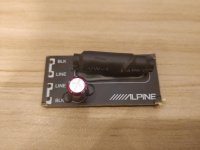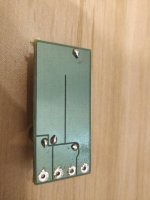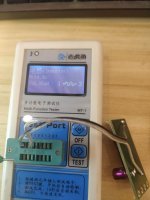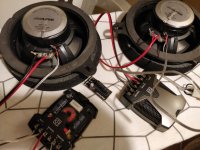Hey guys,
I'm finetuning my car audio setup and replacing the standard crossovers with something more capable.
The original crossovers where a simple inductor and capacitor in line with the tweeter and for the rear coaxials it was just a simple 4.7uf capacitor on its own.
I've asked Alpine for the specsheets of the woofers and tweeters but no response. I can't find any usable info on the frequency operating range of the tweeter so I'm kind of in need of reverse engineering the provided crossover to have a guess how low the tweeter can go and design the new crossovers.
Point is. I have no idea how to simply reverse engineer them. I don't know the inductance of the tweeters. But I guess there is something I can do with a resistor instead to measure. But I'm not 100% sure how to do it.
I've got a Fluke multimeter and a device to measure parts by putting a current through it like transistors and in this case the inductor.
The inductor measures 14.3ohm and 0.35mH
The capacitor is 4.7uf
I'm pretty sure this should be enough to figure out the intended crossover frequency of the manufacturer. But not sure how to calculate it reliably.
Can anyone point me out in the right direction?
I'm finetuning my car audio setup and replacing the standard crossovers with something more capable.
The original crossovers where a simple inductor and capacitor in line with the tweeter and for the rear coaxials it was just a simple 4.7uf capacitor on its own.
I've asked Alpine for the specsheets of the woofers and tweeters but no response. I can't find any usable info on the frequency operating range of the tweeter so I'm kind of in need of reverse engineering the provided crossover to have a guess how low the tweeter can go and design the new crossovers.
Point is. I have no idea how to simply reverse engineer them. I don't know the inductance of the tweeters. But I guess there is something I can do with a resistor instead to measure. But I'm not 100% sure how to do it.
I've got a Fluke multimeter and a device to measure parts by putting a current through it like transistors and in this case the inductor.
The inductor measures 14.3ohm and 0.35mH
The capacitor is 4.7uf
I'm pretty sure this should be enough to figure out the intended crossover frequency of the manufacturer. But not sure how to calculate it reliably.
Can anyone point me out in the right direction?
Attachments
f=1/(2*pi*sqrt(L*C))
4.7uF and 0.35mH yields about 3.9kHz
The impedance of the tweeter will determine filter Q, that won't matter much in a car application. No crossover on the woofer?
4.7uF and 0.35mH yields about 3.9kHz
The impedance of the tweeter will determine filter Q, that won't matter much in a car application. No crossover on the woofer?
There were no crossovers on the woofers and it sounded horrible.
I used the DSP to filter out lower frequencies but hearing the woofers try to do the higher frequencies was just horrible too.
I already installed new crossovers at 12db 3.3KHz frequency which sounds alright to me. But there is 600mhz difference with your calculation. Would it be dangerous for my tweeters?
I used the DSP to filter out lower frequencies but hearing the woofers try to do the higher frequencies was just horrible too.
I already installed new crossovers at 12db 3.3KHz frequency which sounds alright to me. But there is 600mhz difference with your calculation. Would it be dangerous for my tweeters?
Attachments
The advertisement said that the speakers are built to handle a lot of power which obviously doesn't state how much but it's an indicator that they are a bit more sturdy than your regular stock speakers. And the amp I'm using is pretty low power at 25 watt RMS So I guess all should be fine. It sounds great at least. I was just a little worried about damaging them.
Let's say I want to raise the crossover frequency a few hundred Hertz to let's say 3600. How would this translate to changing the 12uf and 5.6uf capacitors in my crossover?
The 12uf and 5.6uf provide 3.3kHz with a 12db slope by specsheet of the crossovers. I haven't measured the inductors yet.
The 12uf and 5.6uf provide 3.3kHz with a 12db slope by specsheet of the crossovers. I haven't measured the inductors yet.
Last edited:
Choose one component (L or C) for the new frequency. Use the formula in post #2 with 3600, to find the other component.
How it behaves depends on whether you reduce the inductance (increases the Q factor), or the capacitance (reduces Q).
How it behaves depends on whether you reduce the inductance (increases the Q factor), or the capacitance (reduces Q).
The capacitance should be in Farads (5.6uF=5.6*10^(-6)F). The resulting L is naturaly in Henries (H).
edit: Frequency (Hz), L(H), C(F)
edit: Frequency (Hz), L(H), C(F)
Alright calculating new values with some algebra calculator (saving a shitload of time on that one haha) and coming at
5.6uf ->4.7uf
12uf -> 10.2uf (10uf will do I guess?) or change the inductor wind a bit?
5.6uf ->4.7uf
12uf -> 10.2uf (10uf will do I guess?) or change the inductor wind a bit?
4.7uF and 10.0uF are std values, easy to find. Use them unless you just want to play with the inductors.
BUT...
Keep in mind you're changing fc less than 10%. It's not uncommon for an electrolytic cap to be rated at 20% tolerance. Unless you buy a batch and measure for accuracy, your new 10uF cap *could* be anywhere from 8uF-12uF.
BUT...
Keep in mind you're changing fc less than 10%. It's not uncommon for an electrolytic cap to be rated at 20% tolerance. Unless you buy a batch and measure for accuracy, your new 10uF cap *could* be anywhere from 8uF-12uF.
Yeah so I'll put in some decent quality film caps for the high frequencies and a good quality bipolar electrolytic for lower frequencies and I'll buy a batch indeed. And measure them.
The 4.7uf caps from the original hpf were also 5.1uf instead of 4.7uf.
And to be sure lowering cap values is supposed to raise freqeuncies with the same inductor value right ?
The 4.7uf caps from the original hpf were also 5.1uf instead of 4.7uf.
And to be sure lowering cap values is supposed to raise freqeuncies with the same inductor value right ?
Amazing guys. Thanks for the quick help. I'll solder in some new capacitors in the front crossovers and see how it sounds.
A closer listening session on higher volumes did make me wonder if they weren't a little bit distorting. With some more mid frequency heavy rock and voices.
A closer listening session on higher volumes did make me wonder if they weren't a little bit distorting. With some more mid frequency heavy rock and voices.
Remember that if you are using an amp with an active cross over built in and it is active you must take that in to consideration as it will change the slope of the passive network. Depending on the combination you are using there could be quite a difference between your target curve and what you end up with. It can also throw the passive network out of phase so you need to be aware that too. Car audio can get real tricky because every car is different and every seat has at least one channel that is off axis. The rules for home HiFi or home theater don't always a ply in the same way for car audio. Car audio can take advantage of psychoacostics to fix problems that you wouldn't do in a home system.
When using an active network on the amp you maybe able to do away with the passive network on the woofer all together and just a 1st order (polypropylene metalized film cap.)on the tweeter and all is good in the hood. If they are Alpine components then chances are they are fairly well matched in sensitivity so running them both (woofer and tweeter) on a single stereo channel would most likely be fine. Just don't ever run it with the woofer out of the circuit or you might let the magic smoke out of your amp.
What series are the alpines you are using?
My personal opinion......Alpine makes good head units, decent amps depending on series chosen and their R series sub woofers can do a decent job with SPL but are not a speaker I would use in a SQ focused system. The rest of their speakers (components and coaxial) I wouldn't waste my time with them. I've just never heard any I liked. That is just my opinion and you may not agree.
When using an active network on the amp you maybe able to do away with the passive network on the woofer all together and just a 1st order (polypropylene metalized film cap.)on the tweeter and all is good in the hood. If they are Alpine components then chances are they are fairly well matched in sensitivity so running them both (woofer and tweeter) on a single stereo channel would most likely be fine. Just don't ever run it with the woofer out of the circuit or you might let the magic smoke out of your amp.
What series are the alpines you are using?
My personal opinion......Alpine makes good head units, decent amps depending on series chosen and their R series sub woofers can do a decent job with SPL but are not a speaker I would use in a SQ focused system. The rest of their speakers (components and coaxial) I wouldn't waste my time with them. I've just never heard any I liked. That is just my opinion and you may not agree.
I already have the speakers and they are fine for the job. It's a car environment.. not a music studio...
The subwoofer is doing a fine job and the speakers need a little bit of tuning.
The amp is a 4 channel amp with no crossover seperation for woofer and tweeter. Just upper and lower cut off with DSP.
I do need the crossovers. The speakers sounded bad with the original provided solution.
The subwoofer is doing a fine job and the speakers need a little bit of tuning.
The amp is a 4 channel amp with no crossover seperation for woofer and tweeter. Just upper and lower cut off with DSP.
I do need the crossovers. The speakers sounded bad with the original provided solution.
Got capacitors in. The 4.7uf are all 4.9uf but the 10uf are way out of spec between 11.2 and 11.5uf
4.9uf will result in a 3.5KHz frequency and 11.2uf will result in 3.45KHz. there is a 50hz gap.
The I'm guessing in a car environment this won't be noticable ? it's a mere 50hz gap. Any concerns ?
4.9uf will result in a 3.5KHz frequency and 11.2uf will result in 3.45KHz. there is a 50hz gap.
The I'm guessing in a car environment this won't be noticable ? it's a mere 50hz gap. Any concerns ?
- Status
- Not open for further replies.
- Home
- Loudspeakers
- Multi-Way
- Reverse engineer simple crossover to calculate crossover frequency





